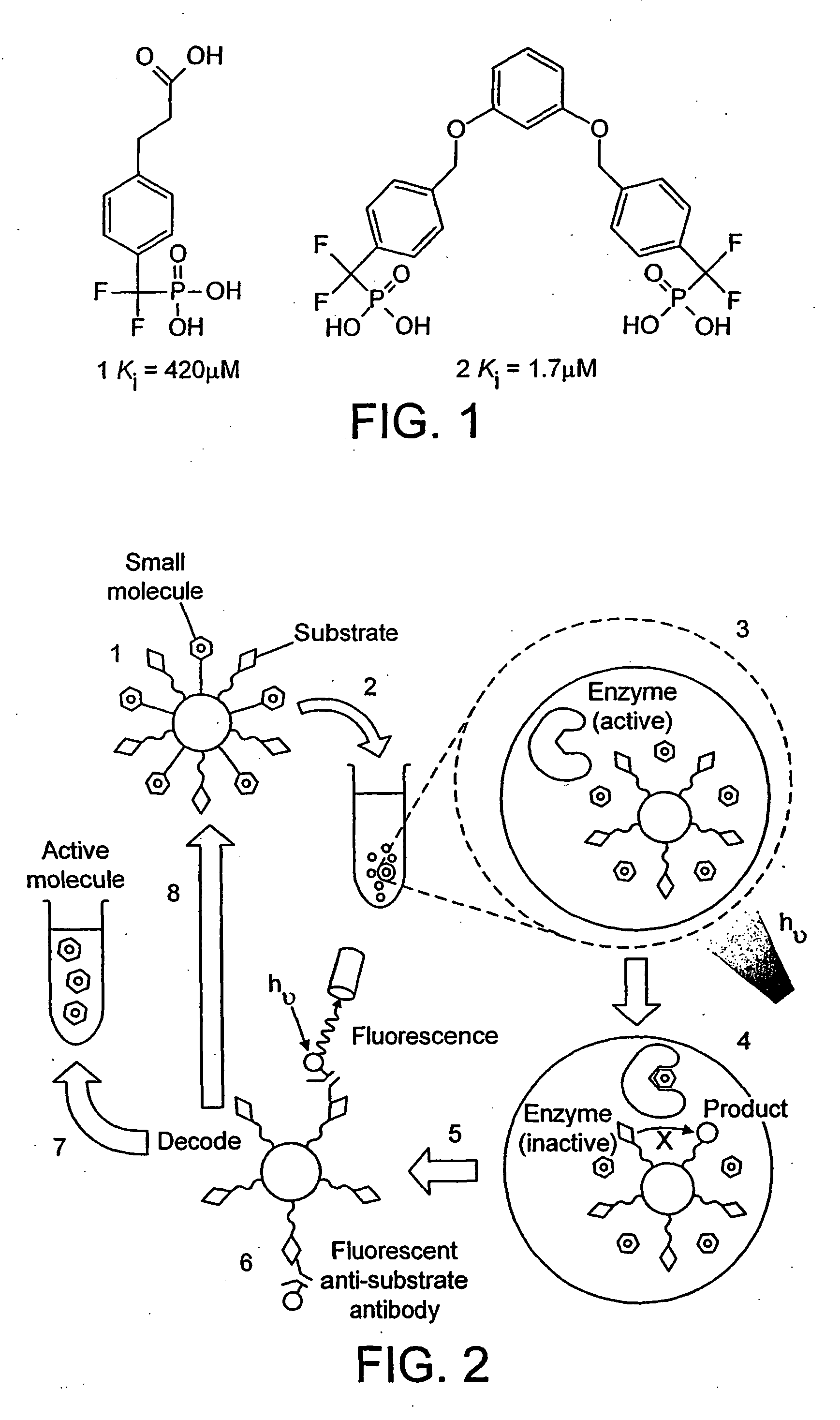Selection by compartmentalised screening
a screening and compartmentalisation technology, applied in the field of screening by compartmentalisation, can solve the problems of difficult identification of the structure of a hit compound, less widespread adoption, and complicating both synthesis and analysis, and achieves high-throughput screening, low cost, and rapid
- Summary
- Abstract
- Description
- Claims
- Application Information
AI Technical Summary
Benefits of technology
Problems solved by technology
Method used
Image
Examples
example 1
[0196] Screening for Inhibitors of the Enzyme Protein Tyrosine Phosphatase 1B (PTP1B)
[0197] PTP1B is a negative regulator of insulin and leptin signal transduction. Resistance to insulin and leptin are hallmarks of type 2 diabetes mellitus and obesity and hence PTP1B is an attractive drug target for diabetes and obesity therapy (Johnson et al., 2002). Two water-in-oil emulsions are made as follows.
[0198] A solution of 1% (w / v) Span 60 and 1% (w / v) cholesterol in decane (all from Sigma Aldrich) is prepared by dissolving 80 mg of Span 60 and 80 mg of cholesterol into 7.84 ml of decane. The decane is heated to 45° C. to allow complete solubilization of the surfactant and cholesterol. The surfactant / decane solution is divided over batches of 200 μl and placed in a block-heater at 37° C.
[0199] A hand-extruding device (Mini extruder, Avanti Polar Lipids Inc, Alabaster, Ala., USA) is assembled according to the manufacturer's instructions. For extrusion, a single 19 mm Track-Etch polycar...
example 2
[0205] Two aqueous mixtures are made on ice (to prevent reaction). The first mixture contains 100 μM compound 2 (FIG. 1), which has a bis-difluoromethylene phosphonate and is a known PTP1B inhibitor (Johnson et al., 2002), the target enzyme (human recombinant PTP1B, residues 1-322; Biomol Research Laboratories, Inc.) at 5 mU / ml, the fluorogenic PTP1B substrate 6,8-difluoro-4-methylumbelliferyl phosphate (iD MFP) (Molecular Probes), and 100 μM Texas Red (Sigma; excitation / emmission maxima 595 / 615 nm; red fluorescence) in a buffer compatible with PTP1B activity (25 mM HEPES, pH 7.4, 125 mM NaCl, 10% glycerol 1 mM EDTA) (Doman et al., 2002). A second mixture is created identical to the above but containing 100 μM hydrocinnamic acid (Aldrich), a compound that is not a PTP1B inhibitor, in place of compound 2, and 100 μM calcein (Sigma; excitation / emmission maxima 470 / 509 nm; green fluorescence) in place of Texas Red.
[0206] 50 μl of each of the compound mixtures is added sequentially to ...
example 3
[0207] Screening of PTP1B Inhibitors From a Compound Library
[0208] 100 water-in-oil emulsions are made on ice (to prevent reaction) as in example 1. The first emulsion is made by dispersing a mixture of 100 μM compound 2 (FIG. 1), which has a bis-difluoromethylene phosphonate and is a known PTP1B inhibitor (Johnson et al., 2002), the target enzyme (human recombinant PTP1B, residues 1-322; Biomol Research Laboratories, Inc.) at 5 mU / ml, the fluorogenic PTP1B substrate 6,8-difluoro-4-methylumbelliferyl phosphate (DiFMUP) (Molecular Probes), and a pre-defined ratio of Qdot™ Streptavidin Conjugates with emmission maxima at 585 nm, 655 nm and 705 nm (Quantum Dot Corporation, Hayward Calif.) in a buffer compatible with PTP1B activity (25 mM HEPES, pH 7.4, 125 mM NaCl, 10% glycerol, 1 mM EDTA) (Doman et al., 2002). The 99 other water-in-oil emulsions are identical to the above but each contain one of 99 carboxylic acids from the Carboxylic Acid Organic Building Block Library (Aldrich) in ...
PUM
| Property | Measurement | Unit |
|---|---|---|
| volume | aaaaa | aaaaa |
| diameters | aaaaa | aaaaa |
| molecular weight | aaaaa | aaaaa |
Abstract
Description
Claims
Application Information
 Login to View More
Login to View More - R&D
- Intellectual Property
- Life Sciences
- Materials
- Tech Scout
- Unparalleled Data Quality
- Higher Quality Content
- 60% Fewer Hallucinations
Browse by: Latest US Patents, China's latest patents, Technical Efficacy Thesaurus, Application Domain, Technology Topic, Popular Technical Reports.
© 2025 PatSnap. All rights reserved.Legal|Privacy policy|Modern Slavery Act Transparency Statement|Sitemap|About US| Contact US: help@patsnap.com


